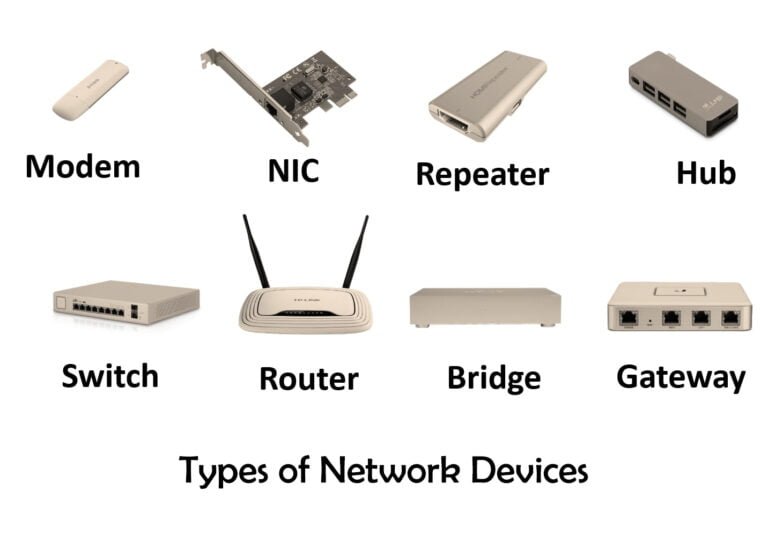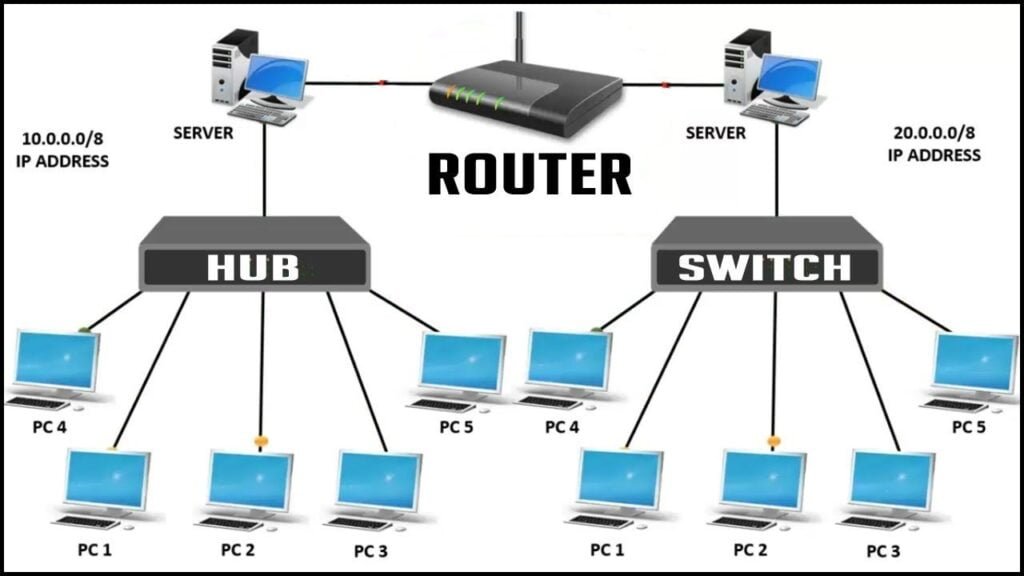What are Network Devices?
Network devices are essential components that facilitate communication between different hardware in a computer network. They are also referred to as physical devices, networking hardware, network equipment or computer networking devices. Each network device has a specific function and is responsible for performing different tasks at various segments of the network. These devices are crucial for the efficient functioning of the network and help to ensure that data is transmitted seamlessly and securely across the network. Examples of network devices include routers, switches, hubs, modems, and firewalls, among others.
Types of Network Devices?

1.Hub
2.Switch
3.Router
4.Gateway
5.Modem
6.Repeater
7.NIC

1. Hub: A hub is a type of network device that connects multiple devices on a network. It works as a multi-port repeater, allowing different branches to connect and communicate with each other. However, unlike other network devices, hubs do not have the intelligence to filter or manage data packets. This means that all connected devices receive all data packets, leading to inefficiencies and wastage.
There are different types of hubs, including active hubs, passive hubs, and intelligent hubs.
Active hub:- An Active hub is a type of network device that has its Power supply and can clean, boost, and relay signals along the network. It serves as both a repeater and a wiring center, allowing different branches to connect and communicate with each other. Active hubs are typically used to extend the maximum distance between nodes on a network.
passive hub :- A passive hub is a type of network device that collects wiring from nodes and power supply from an active hub. These hubs simply relay signals onto the network without cleaning or boosting them, making them less efficient than active hubs.
intelligent hub :- An intelligent hub is a type of network device that works like an active hub but includes additional features such as remote management capabilities. This added intelligence allows administrators to monitor traffic passing through the hub and configure each port in the hub, making it a more flexible and powerful network device.

2.Switch: A switch is a type of network device that is used to connect multiple computers in a network. It is capable of sending private messages from the sender to the intended receiver by storing the MAC address of all connected devices. When it receives a message, it checks the MAC address of the message and sends it only to the receiver that matches the MAC address.
Unlike a hub, which sends messages to all connected devices, a switch only sends messages to the intended recipient. This is known as unicast, which helps to reduce network congestion and improve performance. Additionally, switches provide higher security than hubs, as they are less susceptible to unauthorized access.
Switches also use full-duplex transmission mode, which allows computers to send and receive messages simultaneously. This mode of transmission helps to reduce network delays and improves overall performance.
While switches are more secure and efficient than hubs, they can be more difficult to set up in a network. However, once configured, they provide a reliable and high-performing networking solution for connecting multiple devices.

3.Router: A router is a network device that routes data packets based on their IP addresses. Unlike switches, which operate at the Data Link Layer, routers operate at the Network Layer. They interface LANs and WANs and have a progressively refreshing directing table that assists them with settling on choices on the best way to course information parcels.
When a data packet is received, the router checks its destination IP address against its routing table to determine the best path for the packet to take. This process helps to ensure that the data packet reaches its intended destination in the most efficient manner possible.
One of the key benefits of routers is their ability to divide broadcast domains. This means that hosts connected through the router are in separate broadcast domains, which helps to reduce network congestion and improve performance. Additionally, routers provide a layer of security by acting as a firewall and filtering incoming and outgoing traffic based on certain criteria.

4.Gateway: A gateway is a network device that connects dissimilar computers or networks. It plays an important role in enabling communication between different network segments, even if they use different protocols or technologies.
When a computer in a LAN network wants to access data, the gateway is responsible for routing the request to the appropriate destination. If the data is present within the LAN network, the gateway can retrieve it and provide it to the requesting computer. However, if the data is not present within the LAN, the gateway will connect to the WAN and retrieve the data before forwarding it to the requesting computer.
Gateways can operate at all seven layers of the OSI model and are essential for accessing the internet. However, they are often expensive to purchase and maintain, and their intelligence is generally limited compared to other network devices like routers or switches. Additionally, data transfer rates through a gateway may be slower due to the extra processing required.

5.Modem: Modems, or modulators-demodulators, are devices used to enable the transmission of digital signals over analog telephone lines. When digital signals are transmitted, they are converted by the modem into analog signals of varying frequencies, and then sent to a modem at the receiving end. Once received, the modem performs the opposite transformation, converting the analog signal back into a digital one and then providing it to a device, typically a computer, connected to the modem.
The digital data is usually transferred to or from the modem over a serial line through an industry-standard interface called RS-232. DSL services are offered by many telephone companies, while cable operators use modems as end terminals for identifying and recognizing home and personal users.
Modems work on both the Physical and Data Link layers of the OSI model. The physical layer pertains to the physical transmission medium, such as the telephone line, while the data link layer ensures that data is transmitted correctly and efficiently over the physical layer.

6.Repeater: A repeater is a network device that operates at the physical layer and helps extend the reach of a network signal by regenerating it before it becomes too weak or corrupted. Unlike an amplifier, a repeater doesn’t strengthen the signal, but rather copies it bit by bit and regenerates it at its output port to restore its original strength. It is typically used in star topology connectors to connect different branches of a network and is a 2-port device. By regenerating the signal, repeaters help ensure that data is transmitted reliably across longer distances within the network.

7.NIC: A NIC, or Network Interface Card, is an essential component in establishing a connection between a computer and a network. The card is installed inside the computer and has a unique identifier that is assigned to it. It has a connector on the card where a cable can be attached, which acts as the interface between the computer and the router or modem. The NIC card is responsible for transmitting and receiving data between the computer and the network. It works on both the physical and data link layers of the network model, making it a vital part of the network infrastructure.

